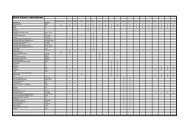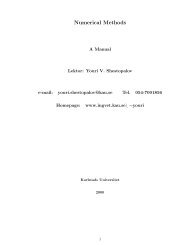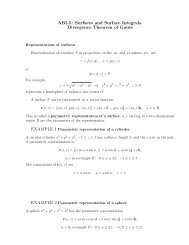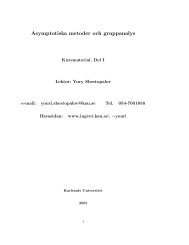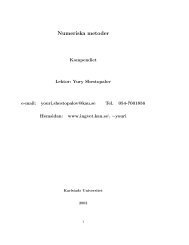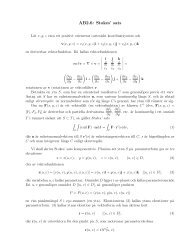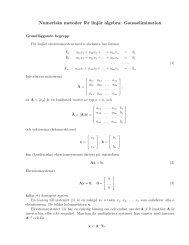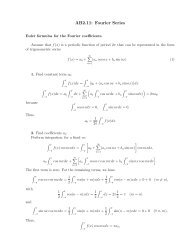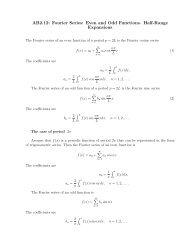Create successful ePaper yourself
Turn your PDF publications into a flip-book with our unique Google optimized e-Paper software.
Expand the right-hand side in the Chebyshev polynomials of the first kindN−1−πn=0f N (y) = f 02 T 0(y) +N∑f k T k (y), (359)k=1where coefficients f k are calculated by (329). Substitute (358) and (359) into (348) and use(336) to obtain∑b n T n+1 (y) = f 0N∑2 T 0(y) + f k T k (y), (360)where unknown coefficients b n are determined form (360),k=1b n = − 1 π f n+1, n ≥ 0.Equality (360) holds only if f 0 = 0. Consequently, we cannot state that the solution to (348)exists for arbitrary function f(y). The (unique) solution exists only if f(y) satisfies the orthogonalitycondition∫1−1dyf(y) √ = 0, (361)1 − y2which is equivalent to the requirement f 0 = 0 (according to (329) taken at n = 0). Note that,when solving equation (348), we impose, unlike equation (356), the condition (361) for equation(346), on the known function f(y). As a result, we obtaina unique approximate solution to (348) for every N ≥ 2anda unique exact solution to (348)ϕ N (x) = − 1 πN−1 ∑n=0f n+1 U n (x), (362)ϕ(x) = − 1 ∞∑f n+1 U n (x). (363)πn=0We will solve equations (348) and (349) under the assumption that the right-hand sidef ∈ L (1)2 and ϕ ∈ L (2)2 . Series (363) converges in the norm of the space L (2)2 .The solution of equation (349) is similar to that of (348). The difference is that K 2 (x, y) isapproximately replaced by a partial sum of the Fourier–Chebyshev seriesK 2 (x, y) ≈ K (2)N−1 ∑N (x, y) =N∑i=0 j=0k (2)ij U i (x)T j (y). (364)Substituting (358), (359), and (364) into equation (349) we obtain a linear equation systemwith respect to unknowns b n . As well as in the case of equation (348), the solution to (349)exists not for all right-hand sides f(y).The method of decomposing in Fourier–Chebyshev series allows one not only to solve equations(348) and (349) but also verify the existence of solution. Consider an example of anequation of the form (349) that has no solution (not solvable).69



